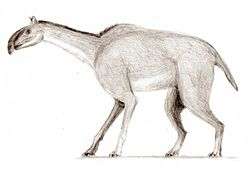Macraucheniidae
| Macraucheniidae Temporal range: Eocene–Pleistocene | |
|---|---|
 | |
| Macrauchenia | |
| Scientific classification | |
| Kingdom: | Animalia |
| Phylum: | Chordata |
| Class: | Mammalia |
| Order: | †Litopterna |
| Family: | †Macraucheniidae Gill, 1872 |
Macraucheniidae is a family in the extinct South American ungulate order Litopterna, with similarities to the camel and rhinoceros. The reduced nasal bones of their skulls suggest that they may have had a small proboscis, or trunk. Their hooves were similar to those of rhinoceroses today, with a simple ankle joint and three digits on each foot. Thus, they may have been capable of rapid directional change when running away from predators, such as large phorusrhacid terror birds, sparassodont marsupials, and saber-toothed cats (Smilodon). Macraucheniids probably lived in large herds to gain protection against these predators, as well as to facilitate finding mates for reproduction.
The family Macraucheniidae includes genera such as Theosodon, Xenorhinotherium, and Macrauchenia. Macrauchenia is the best-known and most recent macraucheniid. It became extinct during the Pleistocene Epoch. It was one of the few litopterns to survive the ecological pressures of the Great American Interchange between North and South America, which took place after the Isthmus of Panama rose above sea level some 3 million years ago. It may instead have died out in the aftermath of the invasion of the Americas by human hunters. When Macrauchenia died out, so too did the Macraucheniidae and the entire litoptern order.
Sequencing of mitochondrial DNA extracted from a Macrauchenia patachonica fossil from a cave in southern Chile indicates that Macrauchenia (and by inference, Litopterna) is the sister group to Perissodactyla, with an estimated divergence date of 66 million years ago.[2] Analysis of collagen sequences obtained from Macrauchenia and Toxodon gave the same conclusion, adding notoungulates to the sister group clade.[3][4]
Genera
Subfamily Cramaucheniinae
- Caliphrium
- Coniopternum
- Cramauchenia
- Notodiaphorus
- Phoenixauchenia
- Pternoconius
- Theosodon
Subfamily Macraucheniinae
- Cullinia
- Macrauchenia
- Macrauchenidia
- Oxyodontherium
- Macraucheniopsis (=Macrauchenia?)
- Oxyodontherium
- Paranauchenia
- Promacrauchenia (=Macrauchenia?)
- Scalabrinitherium
- Windhausenia
- Xenorhinotherium
Subfamily Sparnotheriodontinae
- Decaconus
- Guilielmofloweria
- Megacrodon
- Oroacrodon
- Periacrodon
- Phoradiadius
- Polymorphis
- Sparnotheriodon
- Victorlemoinea (=Sparnotheriodon?)
References
- ↑ Dozo, M.T. & Vera, B. (2010). "First skull and associated postcranial bones of Macraucheniidae (Mammalia, Litopterna) from the Deseadan SALMA (late Oligocene) of Cabeza Blanca (Chubut, Argentina)". Journal of Vertebrate Paleontology. 30 (6): 1818–1826. doi:10.1080/02724634.2010.520781.
- ↑ Westbury, M.; Baleka, S.; Barlow, A.; Hartmann, S.; Paijmans, J. L. A.; Kramarz, A.; Forasiepi, A. M.; Bond, M.; Gelfo, J. N.; Reguero, M. A.; López-Mendoza, P.; Taglioretti, M.; Scaglia, F.; Rinderknecht, A.; Jones, W.; Mena, F.; Billet, G.; de Muizon, C.; Aguilar, J. L.; MacPhee, R. D. E.; Hofreiter, M. (2017-06-27). "A mitogenomic timetree for Darwin’s enigmatic South American mammal Macrauchenia patachonica". Nature Communications. 8: 15951. doi:10.1038/ncomms15951.
- ↑ Welker, F.; Collins, M. J.; Thomas, J. A.; Wadsley, M.; Brace, S.; Cappellini, E.; Turvey, S. T.; Reguero, M.; Gelfo, J. N.; Kramarz, A.; Burger, J.; Thomas-Oates, J.; Ashford, D. A.; Ashton, P. D.; Rowsell, K.; Porter, D. M.; Kessler, B.; Fischer, R.; Baessmann, C.; Kaspar, S.; Olsen, J. V.; Kiley, P.; Elliott, J. A.; Kelstrup, C. D.; Mullin, V.; Hofreiter, M.; Willerslev, E.; Hublin, J.-J.; Orlando, L.; Barnes, I.; MacPhee, R. D. E. (2015-03-18). "Ancient proteins resolve the evolutionary history of Darwin’s South American ungulates". Nature. 522: 81–84. ISSN 0028-0836. PMID 25799987. doi:10.1038/nature14249.
- ↑ Buckley, M. (2015-04-01). "Ancient collagen reveals evolutionary history of the endemic South American 'ungulates'". Proceedings of the Royal Society B: Biological Sciences. 282 (1806): 20142671–20142671. doi:10.1098/rspb.2014.2671.